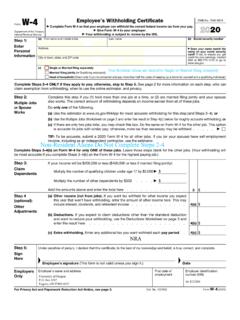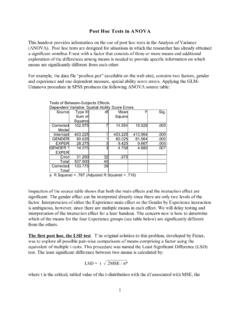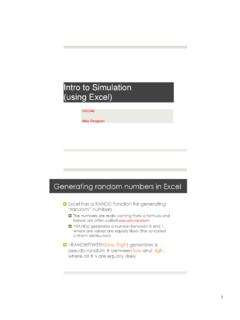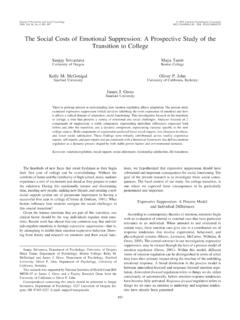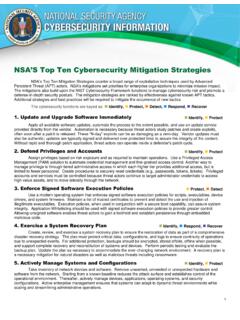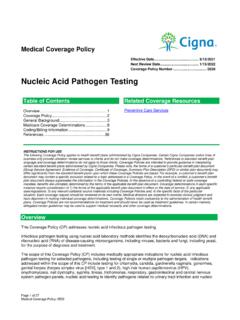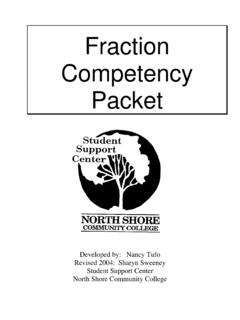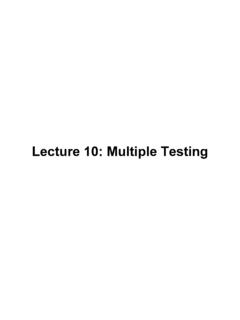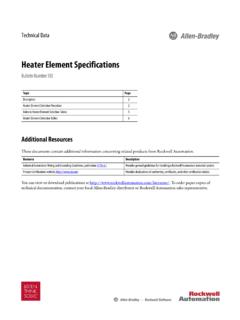Transcription of Interaction Effects in ANOVA - University of Oregon
1 -1- Interaction Effects in ANOVAThis handout is designed to provide some background and information on the analysis andinterpretation of Interaction Effects in the Analysis of Variance ( ANOVA ). This is a complex topicand the handout is necessarily incomplete. In practice, be sure to consult the text and otherreferences on ANOVA (Kirk, 1982; Rosenthal & Rosnow, 1991; Stevens, 1990; Winer, Brown,& Michels, 1991) for additional Effects represent the combined Effects of factors on the dependent measure. When aninteraction effect is present, the impact of one factor depends on the level of the other factor.
2 Partof the power of ANOVA is the ability to estimate and test Interaction Effects . As Pedhazur andSchmelkin note, the idea that multiple Effects should be studied in research rather than the isolatedeffects of single variables is one of the important contributions of Sir Ronald Fisher. Wheninteraction Effects are present, it means that interpretation of the main Effects is incomplete ormisleading. Kinds of interactions . For example, imagine a study that tests the Effects of a treatment on anoutcome measure. The treatment variable is composed of two groups, treatment and control.
3 Theresults are that the mean for the treatment group is higher than the mean for the control what if the researcher is also interested in whether the treatment is equally effective forfemales and males. That is, is there adifference in treatment depending ongender group? This is a question ofinteraction. Inspect the results below. Interaction results whose lines do notcross (as in the figure at left) are called ordinal interactions . If the slope of linesis not parallel in an ordinal Interaction ,the Interaction effect will be significant,given enough statistical power.
4 If thelines are parallel, then there is nointeraction effect. In this case, adifference in level between the two lineswould indicate a main effect of gender; adifference in level for both lines betweentreatment and control would indicate amain effect of treatment. When ordinalinteractions are significant, it is necessary to follow up the omnibus F-test with one of the focusedcomparison procedures described below. Usually, the main Effects can also be interpreted andtested further when they are , when an Interaction is significant and disordinal , main Effects can not be sensiblyinterpreted.
5 The first graph below shows an example of a disordinal Interaction . Disordinalinteractions involve crossing lines. Generally speaking, one should not interpret main Effects in thepresence of a significant disordinal Interaction . For example, in the results shown in the next graph-2-at bottom left, the results of the maineffect of treatment seem to show thatthe treatment mean is higher than thecontrol mean. However, one reallycan t say whether the treatment iseffective or not in general the effectof treatment must be qualifieddepending on which gender isconsidered; as shown in the graph ofthe Interaction at left.
6 Similarly,differences in gender overall aremisleading. While the female mean(averaged over treatments) is higherthan the male mean (averaged overtreatments (see below right), this maineffect result is not really the true stateof affairs. Whether females score higher than males depends on the treatment condition. This isthe essence of an Interaction effect: results and interpretations of one variable s effect or impactmust be qualified in terms of the impact of the second variable. This phenomenon is especially pronounced in the case of disordinalinteractions and as a result, one should avoid interpreting or discussing main Effects when significant disordinal interactions are present.)
7 For example, in thepresent case, results for the F tests of the main Effects should be reported, but interpretationshould be limited to the significant Interaction effect. To determine exactly which parts of theinteraction are significant, the omnibus F test must be followed by more focused tests TESTS OF INTERACTIONSW henever interactions are significant, the next question that arises is exactly where are thesignificant differences? This situation is similar to the issues in finding focused tests of maineffects, but it is also more complex in that interactions represent the combined Effects of twoforces or dimensions in the data not just one.
8 The following section describes four commonapproaches to obtaining more focused, specific information on where differences are in theinteraction 1. Oneway ANOVA . In essence this method assumes that all relevant variance islocated in the cells and there is no meaningful variance associated with the main Effects . Given thisassumption, it is reasonable to analyze the difference among the a by b cell means as though theyare separate groups in a one-factor design. To accomplish this analysis in SPSS it is necessary torecode the ab cells into a one factor design by creating a new grouping variable.
9 For the exampleabove testing the Interaction of gender and treatment, the ONEWAY analysis of the eight cellmeans starts by creating a new, four-level variable named interact :compute interact= interact ( ).if (gender eq 1 and treatment eq 1) interact= (gender eq 1 and treatment eq 2) interact= (gender eq 2 and treatment eq 1) interact= (gender eq 2 and treatment eq 2) interact= SPSS ONEWAY procedure (or a one factor ANOVA using GLM-Univariate) can now beused to analyze the relationship of the four-group variable interact with the dependent procedures or post hoc procedures can be requested in SPSS to test specific differencesbetween cell means.
10 The advantage of this procedure is that it is easily implemented in SPSS. Thedisadvantage of the procedure is that it fails to separately partition out variance due to the maineffects from variance due to the Interaction effect ( a complex topic somewhat beyond the scopeof this class) and it loses the structural or dimensional information about the Interaction ( , inthis case, they re not really four groups but two different dimensions or facets of the data).Method 2. Post Hoc Tests. This method is a direct extension of the application of post hoc testsfor main Effects .
